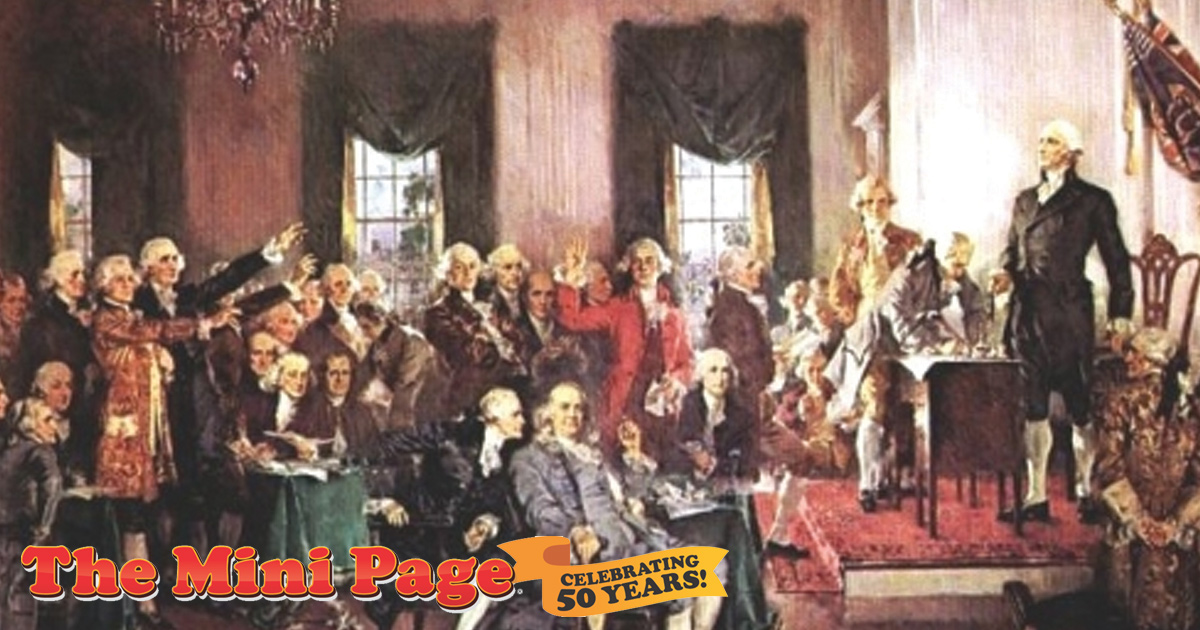
AMP | Kids is proud to announce an ongoing partnership with The Mini Page, now in its 50th year of providing engaging and fun learning opportunities to young readers across the country. This feature was originally syndicated in newspapers the week of September 13 – September 19, 2019. It is distributed digitally here with permission from Andrews McMeel Syndication. Enjoy and share with the young learners in your life!
Sept. 17 is Constitution Day. It was on that day that the delegates to the Constitutional Convention signed the document in 1787. Some schools will celebrate with a whole week of activities. The Mini Page gets started with a “spellbinding” tribute.
C is for Constitution. It is a set of basic laws, organizing, granting and limiting the powers of our government. It is something we all share.
O is for Original. The document has:
- a preamble
- seven articles, or sections
N is for New Hampshire, the ninth state to ratify, or approve, the Constitution.
S is for Signers. Thirty-nine delegates signed. Fifty-five delegates attended. Some, like George Mason, did not sign and insisted that the Bill of Rights be added.
T is for The Bill of Rights, the first 10 amendments to the Constitution.
I is for Independence Hall in Philadelphia, Pennsylvania, where the delegates met to write the Constitution and the Bill of Rights.
T is for Twenty-seven, the total number of amendments, or additions, to the Constitution.
U is for United States. In the words of the Preamble:
“We the People of the United States, in order to form a more perfect union, establish justice, insure domestic tranquility, provide for the common defense, promote the general welfare and secure the blessings of liberty to ourselves and our posterity, do ordain and establish this Constitution for the United States of America.”
T is for Three branches of government.
- The Legislative branch is Congress.
- The Executive branch is headed by the president.
- The Judicial branch is headed by the Supreme Court.
I is for Important Ideas, such as separation of powers, checks and balances and enumerated powers.
O is for Ours. When our Constitution was first created in 1787, our country had 13 states and 4 million people. Today we have 50 states and more than 300 million people.
N is for National Archives. The Constitution is on display at this building in Washington, D.C.
The Bill of Rights
- The first 10 amendments to our Constitution are known as the Bill of Rights. They are:
- First: Guarantees freedom of the press, freedom of speech, freedom of religion, and freedom of assembly and petition.
- Second: Guarantees the right to own and carry weapons.
- Third: Limits government from forcing citizens to keep soldiers in their homes.
- Fourth: Limits searches and seizures.
- Fifth: Grants rights concerning criminal treatment and trials. Also protects citizens from the government taking their property.
- Sixth: Grants further rights for those accused of a crime, such as a speedy trial and a fair jury.
- Seventh: Grants rights for people involved in civil cases (disagreements between two people or people and their government).
- Eighth: Protects people from unreasonable fines or cruel punishment for crimes.
- Ninth: Entitles citizens to rights not listed in the Constitution.
- Tenth: Says that powers not given to the U.S. government by the Constitution are reserved for the states or the people.
Resources
On the Web:
At the library:
-
What Is the Constitution? by Patricia Demuth
-
A Kids’ Guide to America’s Bill of Rights by Kathleen Krull
Teachers: For standards-based activities to accompany this feature, visit Andrews McMeel Syndication. And follow The Mini Page on Facebook!
